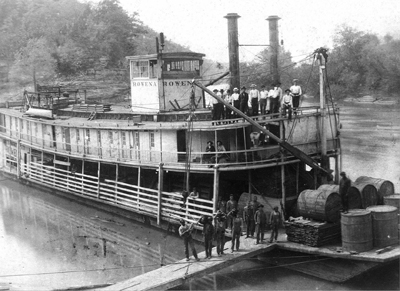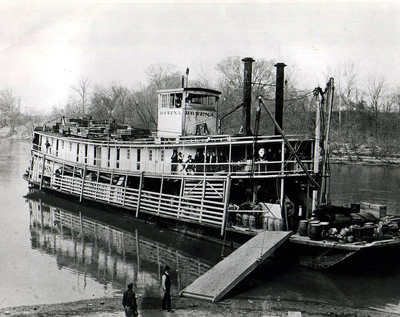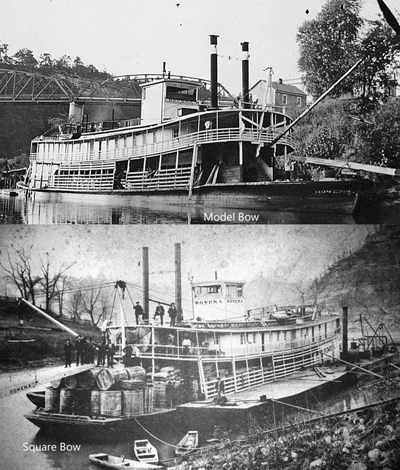|
Rowena,
The Old Lady of the River
By Chris Tramel

She wasn't as grand or extravagant as her Mississippi cousins.
She wasn't built as a floating gambling hall or as a posh
passenger vessel. She was a workhorse, a packet boat, and
supplied towns all along the Cumberland River for nearly 30
years.
Long
before the advent of the airplane that made long distance
travel possible in hours rather than days; before the first
train tracks were laid that connected city to city and coast
to coast; before the days of the automobile and the nation's
highway system, America's rivers and waterways were the country's
main routes of trade and transportation. Most of the nation's
major cities were first settled along the coastal shoreline
or the banks of a river, where the waterways were used to
transport goods and people.
Steam
powered riverboats first appeared on American rivers early
in the 1800s, and for well over 100 years the boats would
be vital to the nation's trade and commerce. The invention
of the steam engine, added to river vessels of shallow drafts,
made transportation of goods and travelers possible in days
where the trip might take weeks overland. As the nation expanded
west, it was the riverboats that supplied frontier towns and
trade routes.

The packet
boat Rowena was built at the end of the steamboat era, in
1904 at Burnside, KY, by the Burnside & Burkesville Packet
Company, and was named for the nearby town of Rowena. Along
with her sister, Celina, the boats were mainly used to move
freight and passengers along the Cumberland River from Kentucky
to all along Middle Tennessee. During times of low water levels
she would sometimes move to the Ohio River, to the Louisville-Evansville
trade route.
A sternwheeler,
the Rowena's flat bottom 148 foot hull was built of oak and
pine. Including her paddles, she had an overall length of
just over 168 feet, and nearly 30 feet in width. She had two
decks, not counting the pilot house, and had a carrying capacity
of 250 tons. As with all riverboats, her hull had a shallow
draft, just a five foot fully loaded, and just 30 inches with
50 tons of coal. Her flat bottom hull was designed to navigate
the shallow sand bars of the Cumberland, and even featured
a capstan, a steam powered winch, on her bow to help drag
the boat across low water areas.

While
her main purpose was to move freight up and down the river,
she also could accommodate up to 60 passengers, with 20 state
rooms, 56 berths, large unobstructed cabin, cook house and
recess. Her cabins were not luxurious by any means. Most were
only six foot by six foot rooms with bunks and a wash stand.
The cabins adjoined the main hall, where dining and seating
areas were set up. Usually the main hall would be separated
midship with a curtain, marking off a women's seating area
and a men's area.
While
her amenities may have been lacking, Rowena did feature something
new for her day. She was outfitted with a complete electric
lighting system, which included two 1000-candle-power searchlights.
Rowena
was a sternwheeler, which meant the paddles that propelled
the boat were located at the rear, or stern of the boat. Other
famous boats, such as the Civil War era Sultana, were side
wheelers, where their paddle wheels were located on the sides
of the boats. During her prime years Rowena featured three
18' boilers, located towards the front of the main deck, that
powered two steam engines at the rear of the boat that produced
275 horsepower. She averaged 10 miles per hour, while burning
12 and a half bushels of coal per hour.
Because
of the flat bottom and need for a shallow draft, the design
of the riverboat was somewhat complicated. Due to the torque
of her engines and the weight of her cargo, riverboats had
to be engineered with a system of diagonal braces and a cable
system, or hogties as they were called. Without the bracing
the hulls would twist and flex. You might think of the steamboats
as floating suspension bridges.
During
her many years of service, the Rowena would stop at river
port towns such as Granville, Carthage, and Gallatin, delivering
supplies and taking on new cargo to their destinations. From
the river ports, supplies would be sent to inland towns such
as Alexandria and Temperance Hall, and agricultural products
such as large barrels of tobacco, or hogsheads as they were
known, would be sent to the ports to ship downstream.
Her cargo
would have been nearly anything, from produce, dry goods,
and furniture, to livestock and building materials. Packet
boats of her day were floating mercantiles that supplied practically
anything you might have found at a general store. The captain
of the Rowena had even given the town of Granville the nickname
"Banana Town," because the town ordered more bananas
than any other town along her stops.
One thing
that stands out about Rowena, and that of her sister, Celina,
was their years of service. With the average life of a riverboat
being only five years, both Rowena and Celina were old ladies
of the river. Steamboats faced several dangers during their
time, including fires and underwater obstacles. Snags, or
sunken tree stumps and logs were one of the most dangerous,
but unlike their seafaring cousins, sinking didn't mean the
end to a riverboat. The steamboat I.T. Rhea sank and was raised
12 times during her service, before sinking a 13th and final
time in 30 foot of water on the Cumberland.
The Rowena
was no different and reportedly sank at least one time, in
1910 just nine miles from Burnside, KY. There she had struck
an obstacle and was steered to a sandbar, where she sank in
shallow water. She was soon raised and repaired but not before
undergoing a major change. When she was first launched the
boat was built with a traditional pointed "duck breast"
bow, but in later photographs, after the sinking, she is shown
with a straight, flat bottom bow. The whole bow of the boat
had been replaced, and she would continued hauling freight
into the 1930s.

The days
of the packet boats have long since passed. In the end it
was a combination of things that saw the end of an era. At
its heyday, the Cumberland River had as many as 45 steamboats
traveling up and downstream at one time. But, as the automobile
became more popular, and new roads being built to accommodate,
soon the boats were competing with emerging trucking companies.
That, combined with the onset of the Great Depression almost
certainly spelled doom for Rowena. By 1931 her travels along
the Cumberland had come to an end, and in 1934, while trying
to move her to Louisville, she sank at Greasy Creek on the
Cumberland.
Not long
after, while trying to pull itself out of the grips of the
Great Depression, the United States implemented massive infrastructure
projects to create jobs. New highways were built, low lying
bridges constructed, and dams were created to control flooding
and produce hydroelectric power. The result doomed the packet
boat industry, especially on the smaller tributaries.
Today
only a handful of the old paddle wheelers still exists, and
they are only novelties, providing river cruises or gambling
options. The days of the chugging steam engines, black smoke,
and the rolling paddlewheels have faded into history. But
if you listen close, you still might hear the faint sound
of the steam whistle, that low howling sound announcing that
the Rowena is coming around the bend.
6/16/2020
- Thanks for stopping by twodawgs1@dtccom.net
|

